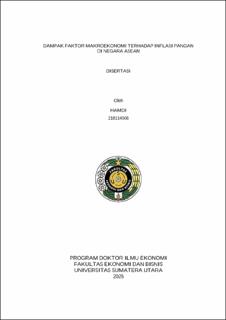| dc.description.abstract | This study analyzes the impact of macroeconomic factors, including money supply, USD exchange rates, food supply, economic growth, lending interest rates, exports, and imports, as well as shock variables such as the yuan exchange rate and wheat prices, on food inflation in ASEAN countries from 2002 to 2021. A Panel Vector Autoregression (PVAR) approach is employed to examine these phenomena. The objective of this research is to identify the primary macroeconomic determinants influencing food price fluctuations in ASEAN. Food inflation expectations in ASEAN tend to shift due to the influence of various macroeconomic indicators, particularly global events such as the Russia-Ukraine conflict, which has driven up global food prices. By utilizing a different approach from previous studies, this research aims to determine the significant macroeconomic variables affecting food inflation in ASEAN.The macroeconomic indicators analyzed through the PVAR approach demonstrate varying impacts on food inflation in ASEAN. In the short term, only variables such as food inflation (IP), unemployment (PG), and GDP have a significant effect on ASEAN's food inflation, while other variables, including money supply (JUB), exchange rate (KURS), interest rate (IR), food supply (SP), imports (IM), and exports (EXP), show no significant influence. However, in the long term, variables such as JUB, KURS, SP, IR, IM, EXP, and yuan exchange rate (NTY) have a significant effect, whereas GDP and wheat prices (HG) do not. Based on the Granger Causality test, there is a bidirectional relationship between GDP and exports (EX) with ASEAN food inflation, while JUB, KURS, SP, NTY, and HG show a unidirectional relationship. In contrast, variables such as IR, IM, and PG have no relationship with ASEAN food inflation. The findings of this study provide valuable insights for policymakers in designing economic and food policies in ASEAN countries. | en_US |


